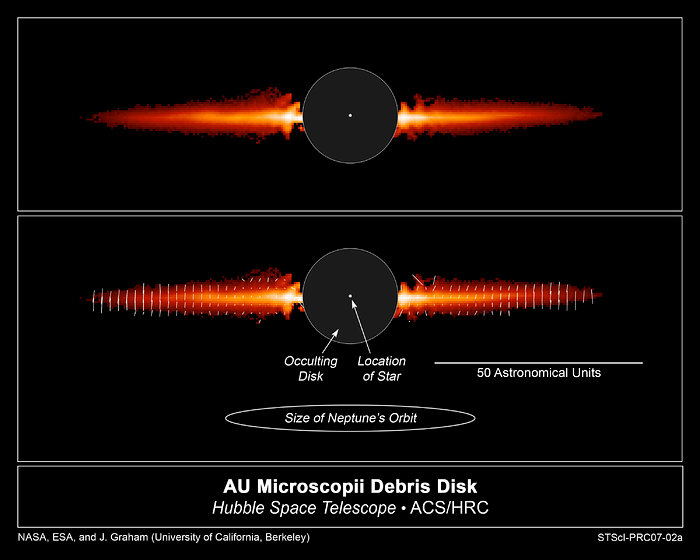Hubble observations provide insight into planet birth
The top view, taken with NASA/ESA Hubble Space Telescope, shows light reflected off dust in a debris disk around the young star AU Microscopii. The bottom frame points out the important features in this image.
The image shows the flattened disk, appearing like Saturn's rings, but seen almost exactly edge-on. Normally, starlight would be so bright that the debris disk could not be seen. But astronomers used the coronagraph on Hubble's Advanced Camera for Surveys, which blocked out most of the starlight. The black circle in the center of the image is the coronagraph's occulting disk. The disk in this image extends to about 8 billion miles (almost 13 billion kilometres) from the star, or three times farther than Neptune is from the Sun. In other observations, the disk has been traced to at least 11 billion miles.
The only light seen is starlight reflected off dust in the debris disk. Astronomers used polarizing filters on the Advanced Camera to analyze the dust in the disk. The polarizing filters allowed astronomers to study how dust is reflecting the starlight. A polarizing filter lets through light vibrating in one orientation while blocking light oscillating in other directions. The white lines in the bottom image illustrate the direction a light wave is oscillating. The length of the line represents the degree to which all the light waves are oscillating in the same direction.
The astronomers used the polarized light from AU Microscopii's disk to deduce information about the size, shape, and other physical properties of the dust. Astronomers used the polarization study to measure the fluffiness of the dust. The dust is roughly 10 times larger than typical interstellar dust grains, which are about the size of smoke particles. These "snowflakes" are evidence of the early steps in the process by which planets grow from tiny dust grains.
AU Microscopii is a 12-million-year-old red dwarf star that is 32 light-years away in the southern constellation the Microscope. It is a ninth magnitude star that can be seen with binoculars or a small telescope from Hawaii and the southern U.S.
The Hubble image was taken Aug. 1, 2004.
Credit:About the Image
About the Object
| Name: | AU Microscopii, GJ 803, HD197481 |
| Type: | Milky Way : Star : Type : Variable : Flare Star Milky Way : Star : Circumstellar Material : Disk |
| Distance: | 30 light years |
| Category: | Stars |
Colours & filters
| Band | Wavelength | Telescope |
|---|---|---|
| Optical V | 606 nm |
Hubble Space Telescope
ACS |
| Optical POL0V | 606 nm |
Hubble Space Telescope
ACS |
| Optical POL60V | 606 nm |
Hubble Space Telescope
ACS |
| Optical POL120V | 606 nm |
Hubble Space Telescope
ACS |
